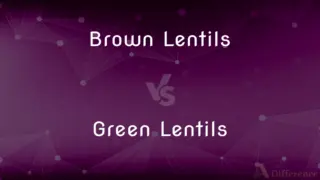Soccer Cleats vs. Baseball Cleats — What's the Difference?
Edited by Tayyaba Rehman — By Fiza Rafique — Published on May 14, 2024
Soccer cleats are designed for agility on grass with low-profile cushioning, while baseball cleats include a toe stud for better traction and are varied in ankle support.

Difference Between Soccer Cleats and Baseball Cleats
Table of Contents
ADVERTISEMENT
Key Differences
Soccer cleats are engineered to enhance a player's touch and feel on the ball, featuring a low cut around the ankles to facilitate freedom of movement and agility. They often have small, conical studs to provide optimal traction on grass fields without excessive grip that could hinder quick movements.
Baseball cleats, on the other hand, are designed with a toe cleat at the front, which helps players gain better traction when running bases and making quick starts or stops. This feature is unique to baseball cleats and is not found in soccer cleats due to the different demands of the sports.
The construction of soccer cleats emphasizes a lightweight design to not only improve a player’s speed but also to offer a closer ball feel, crucial for dribbling, passing, and shooting. The studs can be either metal or plastic, but the overall design prioritizes mobility over stability.
Baseball cleats vary more in their design, offering options with metal spikes for professional play or molded plastic for amateur levels. They also come in low-top and mid-top designs, providing options for ankle support that soccer cleats typically do not offer, reflecting the sport's different physical demands and playing surfaces.
Both types of cleats are crafted to enhance performance in their respective sports, while the key distinctions lie in their stud configurations, the presence of a toe cleat in baseball cleats, and the level of ankle support offered. These differences highlight how each type of cleat is optimized for the specific movements, playing surfaces, and needs of soccer and baseball players.
ADVERTISEMENT
Comparison Chart
Stud Configuration
Small, conical studs for grass traction
Toe stud for better traction, varied stud types
Ankle Support
Low cut for agility
Options for low or mid-top for extra support
Weight
Lightweight for speed and ball touch
Heavier, prioritizing traction and stability
Toe Stud
Absent
Present for improved starts and stops
Primary Surface
Grass fields
Dirt and grass, adaptable to different infields
Compare with Definitions
Soccer Cleats
Designed for grass fields and agility.
He wore his soccer cleats for better control over the ball.
Baseball Cleats
Offer varied ankle support.
Players choose between low and mid-top baseball cleats for desired ankle support.
Soccer Cleats
Feature low-profile cushioning.
Soccer cleats prioritize close ground feel and agility.
Baseball Cleats
Designed for dirt and grass infields.
Baseball cleats provide stability on varied playing surfaces.
Soccer Cleats
Generally lightweight.
The lightweight design of soccer cleats enhances player speed.
Baseball Cleats
Can have metal or plastic spikes.
Professional players often wear metal-spiked baseball cleats.
Soccer Cleats
Lacks a toe stud.
Soccer cleats omit the toe stud to prevent turf snagging during play.
Baseball Cleats
Heavier than soccer cleats.
The added features make baseball cleats slightly heavier.
Soccer Cleats
Low cut for ankle mobility.
The low cut of soccer cleats allows for unrestricted movement.
Baseball Cleats
Include a toe stud for traction.
Baseball cleats have a toe stud to aid in quick starts.
Common Curiosities
Can soccer cleats be used for baseball?
Using soccer cleats for baseball is not recommended due to the absence of a toe stud, which is crucial for baseball-specific movements.
What's the main difference between soccer and baseball cleats?
The main difference lies in their design; soccer cleats are lightweight with a low cut for agility, while baseball cleats include a toe stud for traction and offer more ankle support.
Why do baseball cleats have a toe stud?
The toe stud in baseball cleats provides extra traction needed for quick starts, stops, and directional changes.
Can I use baseball cleats for other sports?
While baseball cleats are designed specifically for baseball, their use in other sports might not offer the same level of performance or could be against the rules of the sport.
Are soccer cleats lighter than baseball cleats?
Yes, soccer cleats are generally lighter than baseball cleats to enhance speed and agility on the field.
What type of cleats are better for artificial turf?
For artificial turf, specialized turf shoes or cleats with numerous small studs are generally better to avoid excessive traction.
Why don't soccer cleats have ankle support?
Soccer cleats lack extensive ankle support to allow for maximum mobility and agility during play.
Do professional soccer players use metal spikes?
Professional soccer players typically use cleats with either plastic or metal studs, depending on the league's regulations and the playing surface.
Is there a difference in the material used for soccer and baseball cleats?
Both soccer and baseball cleats can be made from a variety of materials, but soccer cleats often use lighter, more flexible materials to enhance ball feel and agility.
What should I consider when choosing between soccer and baseball cleats?
Consider the specific needs of your sport, including the type of movements, the playing surface, and the level of ankle support required.
Share Your Discovery

Previous Comparison
Brown Lentils vs. Green Lentils
Next Comparison
Black vs. Off-BlackAuthor Spotlight
Written by
Fiza RafiqueFiza Rafique is a skilled content writer at AskDifference.com, where she meticulously refines and enhances written pieces. Drawing from her vast editorial expertise, Fiza ensures clarity, accuracy, and precision in every article. Passionate about language, she continually seeks to elevate the quality of content for readers worldwide.
Edited by
Tayyaba RehmanTayyaba Rehman is a distinguished writer, currently serving as a primary contributor to askdifference.com. As a researcher in semantics and etymology, Tayyaba's passion for the complexity of languages and their distinctions has found a perfect home on the platform. Tayyaba delves into the intricacies of language, distinguishing between commonly confused words and phrases, thereby providing clarity for readers worldwide.













































